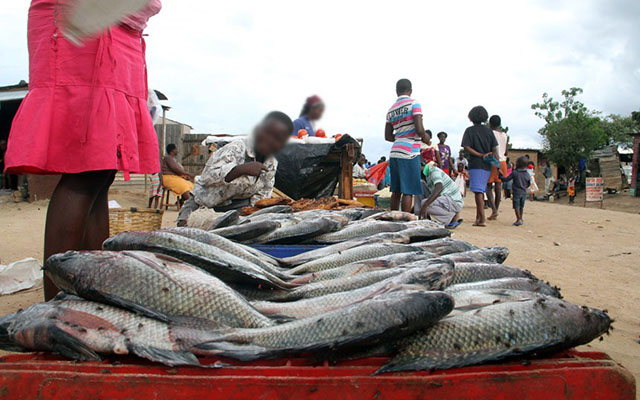Water key for Command Agriculture

 Bumper Harvest with Conrad Mwanawashe
Bumper Harvest with Conrad Mwanawashe
THE expansion of Command Agriculture to include soya beans and wheat in the coming seasons brings to the fore a number of new issues that Government and its partners in the private sector should consider.
Such issues range from the availability of inputs going forward, logistics for the distribution of the inputs and produce as well as land preparations to ensure timely planting.
But another critical dimension that calls for attention is the availability of water throughout the year.
This season, Command Agriculture, financed to the tune of $500 million, targeted only maize, set on 400 000 hectares throughout the country dedicated to grain production for a yield of at least two million tonnes of maize per season.
These targets were mainly on rain-fed agriculture although Government consider some farmers who are close to water bodies.
But to achieve the agricultural targets set out in Command Agriculture and Zim-Asset, there has to be significant investment in water security. This means that the demand for agricultural water will increase from next season putting a strain on the current holding capacity.
Questions relating to how much the country can hold throughout the year and how that water is then expended on agricultural activities arise.
Water harvesting and storage are critical systems that require attention if Zimbabwe is to achieve agricultural targets set out in the Government’s $500 million Command Agriculture programme.
Zimbabwe, being an agro based economy depends on water availability for agricultural activities to be successful.
A large part of the country is semi arid and is characterised by frequent droughts whose negative impacts will worsen in the wake of climate change.
According to the Ministry of Environment, Water and Climate, currently dam levels in the country are now averaging 57 percent storage with most of the country’s dams concentrated along the central watershed of the country. This is where most of the arable land and farms in the country are located. The net capacity of the country’s national dams is around eight billion cubic metres and as at January 26 dams were at 4,6 billion cubic metres.
The Environment, Water and Climate Ministry says in terms of water harvesting infrastructure, Zimbabwe is second in Africa, after South Africa. It is estimated that three quarters of water infrastructure in Africa is found in Zimbabwe and South Africa. But because the country’s water resources are limited, estimated at less than 25 percent of the Sub-Saharan African average, water harvesting and storage systems come into the equation.
Water harvesting is being practiced at different scales. On a small scale it is practiced at house hold levels through harvesting from roof tops and fields and on a large scale through the development of dams which the Government is the main actor together with some private players.
Some of the most common systems include infiltration pits, strip catchment tillage, earth basins and contour ridges.
While Government, through the Environment, Water and Climate Ministry, is working on a number of initiatives to harvest water, it is critical to expedite the initiatives. Government is considering a number of dams to improve the country’s water holding capacity.
One such major project is the completion of Tokwe Mukorsi Dam located at the confluence of the Tokwe and Mukorsi rivers with a capacity of 1,8 billion cubic metres of water. The Mukorsi Dam will enable irrigation of about 25 000 ha of new land in the Lowveld Area where considerable infrastructure is already established.
Existing commercial estates are expected to uptake about half of the water for the expansion of cane and citrus while the other half would serve new schemes to be developed in the communal and resettled areas.
But there are some water challenges that need attention relating to the quantity, location, timing and quality of water.
The challenges include inadequate surface water assessments and monitoring and provision of adequate water supply compounded by widespread pollution as largely affecting service delivery. These challenges have informed Government’s water priorities as it endeavours to ensure availability of enough of water for agricultural purposes, among other requirements.
Some of the priorities include reviving information gathering and documentation, arresting deterioration of the water and sanitation sector, rationalising the institutional and legal framework particularly with regard to environmental protection, and ensuring financial sustainability of the water sector.
Government is also considering budgetary intervention to address the poor maintenance of existing water harvesting infrastructure due to budgetary constraints.
It would be noble for Government to push for Private Public Partnerships in the development of water harvesting infrastructure. Also, Government should intensify disiltation programmes to ensure that rivers and dams are not affected.
According the Ministry of Environment, Water and Climate, siltation of rivers and dams is one of the major threats to water resources availability the country is faced with. Government through the Ministry of Environment, Water and Climate (MEWC) last year launched a disiltation programme which aims at identifying and desilting silted water bodies in the country so as to improve their holding capacity.
The effect of siltation is that the rivers will lose their channel capacity leading to failure to contain river flows which results in increased flooding. The dams will lose their storage capacity leading to failure to sustain water supply for domestic, mining, industrial, agricultural and livelihood sustenance.
Some of the strategies which could be implemented to curb siltation include enforcement of existing laws that outlaw alluvial gold mining in the river bed or close to the stream banks. This includes relocating gardens located within the streams to more than 30m from the highest flood plain level and conservation works to be put in place. Also construction of contours and other soil conservation works in the fields to ensure that the rate of soil erosion and sedimentation of water sources is reduced.
Furthermore, the area reserved for dam servitudes should be increased so that a bigger area of the dam catchment is protected from agricultural/mining activities.
This may require policy interventions in the form of a statutory instrument to gazette areas along a river and dam catchment as state or protected areas and put under the management of the water authority.
Traditional leaders could also be engaged so that they play a central role in environmental management and improve the health of water sources. In that regard, traditional leaders should be further empowered to effectively deal with all issues of the environment including stream bank cultivation.
As Government has adopted Command Agriculture as a permanent programme for agriculture aimed at ensuring food security, expanding it to look into issues of water availability and security is key.











Comments